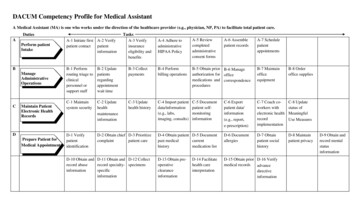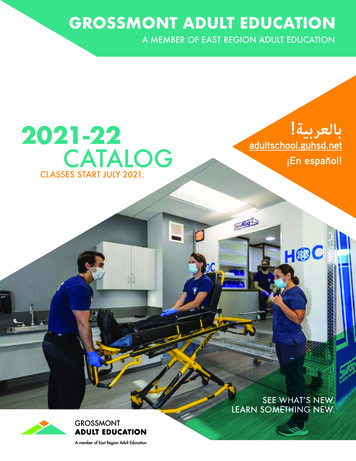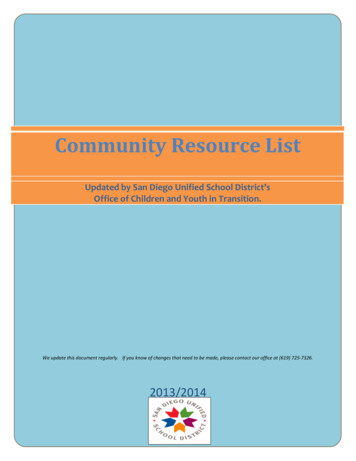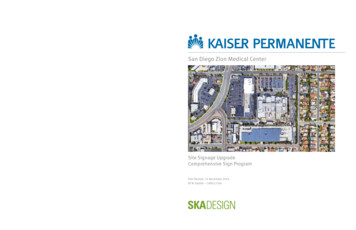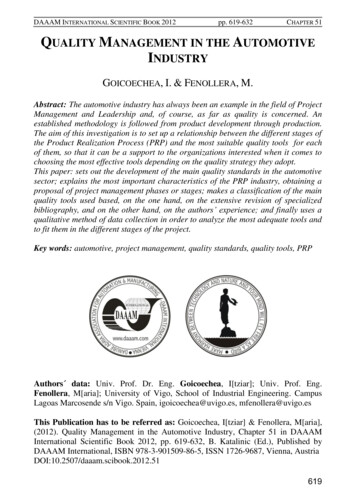
Transcription
DAAAM INTERNATIONAL SCIENTIFIC BOOK 2012pp. 619-632CHAPTER 51QUALITY MANAGEMENT IN THE AUTOMOTIVEINDUSTRYGOICOECHEA, I. & FENOLLERA, M.Abstract: The automotive industry has always been an example in the field of ProjectManagement and Leadership and, of course, as far as quality is concerned. Anestablished methodology is followed from product development through production.The aim of this investigation is to set up a relationship between the different stages ofthe Product Realization Process (PRP) and the most suitable quality tools for eachof them, so that it can be a support to the organizations interested when it comes tochoosing the most effective tools depending on the quality strategy they adopt.This paper: sets out the development of the main quality standards in the automotivesector; explains the most important characteristics of the PRP industry, obtaining aproposal of project management phases or stages; makes a classification of the mainquality tools used based, on the one hand, on the extensive revision of specializedbibliography, and on the other hand, on the authors’ experience; and finally uses aqualitative method of data collection in order to analyze the most adequate tools andto fit them in the different stages of the project.Key words: automotive, project management, quality standards, quality tools, PRPAuthors data: Univ. Prof. Dr. Eng. Goicoechea, I[tziar]; Univ. Prof. Eng.Fenollera, M[aria]; University of Vigo, School of Industrial Engineering. CampusLagoas Marcosende s/n Vigo. Spain, igoicoechea@uvigo.es, mfenollera@uvigo.esThis Publication has to be referred as: Goicoechea, I[tziar] & Fenollera, M[aria],(2012). Quality Management in the Automotive Industry, Chapter 51 in DAAAMInternational Scientific Book 2012, pp. 619-632, B. Katalinic (Ed.), Published byDAAAM International, ISBN 978-3-901509-86-5, ISSN 1726-9687, Vienna, AustriaDOI:10.2507/daaam.scibook.2012.51619
Goicoechea, I. & Fenollera, M.: Quality Management in the Automotive Industry1. IntroductionIncreasing global competition over the past decade has forced automotivecompanies to improve quality and efficiency. Using the management tools that arerelevant to the organization’s needs has become a strategic issue for companies intoday’s competitive environment.The project quality can be viewed in different ways. The factor of who assessesthe quality, and what is the evaluation based on, is always decisive. However, thebottom line is always determined by customers or skateholders requirements(Nagyova & Pacaiova, 2010). By choosing and applying the best management toolsamong too many management tools, companies can improve their performances andthen increase customer satisfaction and gain market shares.Management is characterized because of its global and comprehensiveapproach; it is and organizational strategy and management methodology that makesthe members of an organization participate with the basic aim of continuouslyimproving efficacy, efficiency and functionality. Automobile quality managementsystem is based on the ISO/TS standard that focuses mainly on processes (Jiménez,2008), and on the satisfaction of customers (intermediate or ultimate); and by whichboth employees and suppliers are involved (Fig. 1).Fig. 1. ISO TS Process ApproachQuality management techniques and tools are instruments and methods thathelp to solve specific problems at different organization levels (AutomotiveCommittee, 2004). There is a wealth of literature above all professional, on thespecific tools related to quality management (Juran & Gryna, 1998; Besterfield et al.,1999; Dale et al., 2007). They have been grouped according to different criteria andmany classifications have been proposed, both in professional and academicliterature; Greene (1993) describes up to 98 tools, grouped by the objectives set bycompanies. The entire automotive industry has embraced quality tools, such asconcurrent engineering, continuous improvement, and statistical process control butthe main difficulty lies in determining what quality practices are the most likely toimprove quality and overall firm performance. This work presents the hands-on620
DAAAM INTERNATIONAL SCIENTIFIC BOOK 2012pp. 619-632CHAPTER 51experience of quality tools use and implementation at each PRP stage within a toplevel supplier company in the automotive industry. The objective of this study is toexplore the strategic implications of quality tools adoption with the aim of buildingtheory. Because the focus of this research is exploratory, the authors qualitative datacollection methods, primarily field-based collection- to help ensure that importantvariables and relationships were identified.2. Quality management frameworks and standardsProducing with “quality” is the philosophy of any company in this industry. Ithas an extensive experience in quality management and this materializes in the formof quality assurance standards that have arisen throughout the years, such as QS, TS,VDA, EAQF, AVSQ, etc. Nowadays it has its own specifications, such as the ISO/TS16949 standard, based on the ISO 9001 model, with specific requirements of theautomotive industry, raising the level of requirements and quality of this standard.2.1 Quality standards developmentThe automotive industry began its activity in the 17th Century, using steam aspropulsion element. After significant progress in gas-powered engine design, the firstpetrol engines emerged in 1889. In the early 20 th Century, mass production ofautomobiles begins in the USA, being leaders in automobile manufacturing. Someyears later, European manufacturers learnt the lessons and built manufacturing plantsin the UK, France, Germany and Italy.In the WWI and WWII period, most automobile manufacturing countriesdrastically reduced their activity. In 1939, General Motors (mainly) and Ford werethe leading company in the US market, Opel and Mercedes-Benz in Germany,Renault, Peugeot and Citroën in France, and Morris, Ford, Vauxhall (of GeneralMotors), Standard and Rootes (Jaguar, Rover and Rolls-Royce makes) in the UnitedKingdom. Car production outside the USA survived mainly because General Motors,Ford and Chrysler established manufacturing plants in other countries. After the war(1945), there was a significant expansion of automotive sector. Large automobilemergers took place to be more competitiveness among manufacturers.Japanese car industry arose in the sixties, with a more competitive andaggressive philosophy of work, based on quality principles. American manufacturersdecide to change their management strategy and form, and military quality standardsare adopted. Already in 1988, their supplies are requested specific requirements. Eachmanufacturer has a manual containing his own requirements and suppliers have tomake an effort to fulfill them; this issue gets complicated when suppliers work forseveral manufacturers at the same time. Aware of this working method not beingcompetitive, the Big Three U.S. automakers (Chrysler, Ford & General Motors,1994) organize a working group whose aim is to unify their different requirementmanuals. This working group efforts became reality in 1994 with the publication ofQS-9000-Quality System Requirements standard, that derives from the 1994 versionof ISO 9000 (Kartha, 2004; Bandyopadhyay, 2005). Later, other Americanmanufacturers of the industry accepted this standard as well.621
Goicoechea, I. & Fenollera, M.: Quality Management in the Automotive IndustryThe German automotive sector reconsidered this issue because of the increasedcompetence, the aim of being more competitive, costs reduction, etc. This is how the“Verband der Deutschen Automobilindustrie“(VDA) arose in Germany; thisorganism makes the VDA 6 Qualitätsstandard der deutschen Automobilindustriestandard; its core part is VDA 6.1 (1996) whose target is to allow for assessmentunder comparable conditions of different quality management systems. Similarly tothe regulations that came into being in the USA and Germany, two more standardsalso sprang up: the Evaluation Aptitude Quality Supplier (FLAA) in France (1994),quality system standards for Citroën, Peugeot and Renault, with regard to theirsuppliers and the Association of Quality System Evaluators (AVSQ) (1995) in Italy.Lately, the automotive industry (like the rest of sectors), follow the globalizationtendency. Not only the main automobile manufacturers, but also their suppliers applyalliance and fusion policies, thus, there is a need for harmonizing the differentregulations on quality management that had arisen in the automotive industry. Thelatest result of this globalization effort is the UNE-ISO/TS 16949 standard, whichreplaces the QS 9000 standard.The first edition of this technical specification (year 1999) was mainly based onthe ISO 9000:1994 standard. In 2002, there was a second edition (UNE-ISO/TS16949:2002) based on ISO 9001:2000. The current version of the specification isISO/TS 16949:2009 (2009). The IATF (International Automotive Task Force) wasestablished to create this standard. The main automotive manufacturers participatedin this working group together with national organizations like VDA and somemembers of ISO TC 176 (technical committee of the ISO organization for qualityrelated regulations). Its quality references are shown in Fig. 2.Fig. 2. Quality references for the sector’s suppliers according to the IATF (source:http://www.aiag.org)622
DAAAM INTERNATIONAL SCIENTIFIC BOOK 2012pp. 619-632CHAPTER 51General Motors and Ford insisted on all its suppliers making the transitionfrom QS 9000 to ISO/TS 16949 before the end of 2006, whereas Chrysler requestedsuch transition in 2004. About 6,000 first and second-level suppliers around theworld have obtained the ISO/TS 16949 certification. American companies are on topof the list, followed by German, French, Spanish, Italian, Chinese, Brazilian andIndian firms (Davis, 2004).2.2 Quality ManagementThe ISO/TS 16949 international standard establishes the particularrequirements of the implementation of ISO 9001:2000 in the automobile production.This is a useful framework to understand the quality planning of the product ingeneral, the PRP, being one of the most important parts of the standard. Broadeningthe project management concept, this standard requires the establishment of a methodso that the PRP is measured up by means of specific milestones, including thecorresponding management analysis and revision. Factors to be accounted for includequality, risks, costs and deadlines.Based on its working method, numerous companies of other sectors have takenthis model of management and have tried to apply it and adapt it to them. It isbecause of this that quality management implementation in the best possibleconditions requires the support of some techniques that contribute to theirdevelopment.While some of these tools can be used to reveal problems with the staffparticipation, others can be drawn from measurements or data obtained from theprocess to be controlled and, after analyzing such data, the intended results areobtained. In some occasions, these results are used to control the process: if theresults are within the limits established for each process, the process is controlled;otherwise, corrective measures will be needed to be applied to it. Some other times,the only interest is to see the results of a process with a graphical representation. Ingeneral, there is a wide number of ways (some of them complex) to control a process,to find failures, to improve systems, to analyze risks, etc.The automotive sector is managed by the Major Automobile Manufacturers(MAM), like Ford, General Motors, Volkswagen, Their working method or Projectmanagement follows specific phases: offer, contract revision, product design, productdesign validation with prototypes, industrialization, product validation and process,and finally production optimization. MAM have Design Centres and ProductionFacilities around the world.Development projects of new vehicles take place at Design Centres; suchprojects have an average 3-year planning for new vehicles and 1 or 1.5-year forvehicle re-styling. Each vehicle component is perfectly designed in this DevelopmentProjects: geometry, functionality, technical characteristics, as well as the interrelationand interferences among them. Each component characteristics and determiningfactors are recorded in the Specification (tender documentation), where drawings,regulations, tests to be undertaken, etc. are specified.623
Goicoechea, I. & Fenollera, M.: Quality Management in the Automotive IndustryMany times at this design stage, MAM s include some suppliers in theirworking team because of their knowhow (experience), that this way participate in thevehicle design. They are known as Development Providers. In the ProductionFacilities, MAM only assemble components. An intermediate stage between designand production is therefore necessary in the Project.That stage is the suppliers’ allocation, which determines which suppliers areresponsible for the mass supply of the different components to production plants. Theso-called Buyer Leader is in charge of suppliers’ allocation. The allocation isperformed on the basis of different criteria: economic (offer), experience, qualityincidents in other supplies, Control and follow-up on suppliers (that reach up to mass supply of allocatedcomponents) by the Manufacturer are critical at this stage. Considering the amount ofcomponents, several Quality Supplier Engineers are appointed. They are responsiblefor controlling that the supplier fulfills some milestones, such as the delivery ofprototypes to the Manufacturer (they are non-representative samples but show thesupplier’s capacity to make parts; at this point the supplier does not have the finalmanufacturing resources) and the deliveries of initial samples (representative piecesof production that have all the necessary working resources, prepared workstation,documents, ).The Quality Supplier Engineer appointed, carries out a Pre-Production audit(Run at Rate), in which the Auditor checks that the Supplier can provide good partsand complies with the frequency requested by the Manufacturer. In order to do this,work stations are analyzed, together with all documents regarding both product andprocess quality.The manufacturer work is based on solid management skills of new vehicledesign project and a subsequent good logistics management; since the Productionfacilities assemble components “just in time”, provided by a great variety ofsuppliers, with almost zero stocks. Those suppliers that provide their productsdirectly to the “Production facilities” are called Tier 1 suppliers. Those who supplyparts to the latter are the Tier 2 suppliers, and so on and so forth: Tier 3, Tier 4suppliers In order to achieve this type of category, supply capacity and quality isneeded to be shown first; therefore, there are some steps or stages throughout theProject that all suppliers in the automotive industry must follow in order to fulfill thesupply requirements or adequate levels. All these stages are reflected in a documentcalled “Product Quality Assurance Dossier” or “Production Part Approval Process”;such document includes all quality requirements and stages to be complied with atthis stage of development of the supplier until mass production.Because of what has been set out, it can be concluded that project managementin the automotive sector is characterized by the stages shown in Fig 3. At each ofthese stages, it is essential and imperative that a range of quality tools are adopted asworking method. All these tools are mainly based on the philosophy of zero defectsand continuous improvement.624
DAAAM INTERNATIONAL SCIENTIFIC BOOK 2012pp. 619-632CHAPTER 51Fig. 3. Project stages in the automotive sector3. Examination and clasification of the quality toolsThis report focuses on the most used tools in the sector and on those forced to beused by the manufacturer as a general rule:1. PDCA cycle or Deming2. Q7: the seven basic tools of quality3. M7: the new seven tools4. Planning techniques5. Control techniques6. Improvement techniquesThe DEMING or PDCA cycleThe PDCA cycle, is used as a work philosophy and is the core principle of ISOTS. This methodology is inherent to the sector on a daily basis and it sets the steps tobe followed to undertake any improvement (Fig. 4). PLAN: Assortment of problems and planning of improvement actions To knowthe problem that is tried to be improved, to look for the root reason, solutions tothis reason,. Here, analytical tools like Q7 are used. DO: Realization of concrete actions to solve the problem To put the necessarymeans for improvement. CHECK: Validation of results and controlling of aims To measure the obtainedresults, to see if the aims are reached ACT: Improvement of actions, of the situation, etc. To extend the solutions toother similar problems, families of pieces 625
Goicoechea, I. & Fenollera, M.: Quality Management in the Automotive IndustryFig. 4. Deming cycleIt is based on the principle of quality management continuous improvement,one of the basis supporting the quality philosophy. It analyzes existing data andfocuses on historical process capability to know the problem, that is to say, onobvious and quantified facts and problems.Q7: The seven basic tools of qualityThey are known by “The Seven Basic Statistical Tools” because they areappropriate for people with little formal education in statistics (Ishikawa, 1985): Check sheet Flow charts Cause-and-Effect Diagrams (fishbone) Control Charts Histograms Pareto Charts Scatter PlotA right approach to deal with issues is to see first if the issue exists by usingverified data (check sheet), quantifying its severity (Jiménez, 2010), if it is repetitiveand representative (histograms, Pareto charts) and using tools like cause and effectdiagrams intending to determine the root reason of the problem. Specifically, and asan example, the scatter plot was used to pursue a test correlative to the hardness andfatigue test applicable to polyurethane seats of any vehicle; such test is usually626
DAAAM INTERNATIONAL SCIENTIFIC BOOK 2012pp. 619-632CHAPTER 51performed 36 hours after their production. A test correlative to the previous one wasfound; it was totally significant, but carried out 6 hours before its production, with theobjective of knowing beforehand if the production carried out is correct or, if thatnew test provides incorrect results, being able to tackle the problem in productionbefore the 36 hours where the problem would be encountered with the standard test.M7: The new seven toolsThis is an assortment of useful tools for decision-taking at management level(Barker, 1989). They are not new, but their popularity has increased in theengineering and manufacturing fields over the last twenty years (Omar & Kleiner,1997). They are planning and management tools aimed at Management: Affinity Diagram Relations Diagram Tree Diagram Matrix Data Analysis Matrix Diagram Process Decision Program Chart (PDPC) Arrow DiagramPlanning techniquesThese tools are aimed at preventing the manufacturing of defective parts(Rodríguez, 2011). They are applied to plan the manufacturing process,manufacturing tools, control frequency, personnel carrying out controls: Benchmarking: competence analysis; it is a systematic, continuous measurementand comparison process to determine “best” practices in order to improve anorganization’s performance (Watts, 2012). QFD (Quality Function Deployment): The core of this approach is a chart calledhouse of quality. This technique identifies customer requirements and provides adiscipline to ensure that those requirements are included in product design and inplanning process. It reduces product development cycles, increasing quality andreducing costs (Chan & Wu, 2002). Capability Studies. They are is used to know if manufacturing processes are stableand capable. This tool is closely related to statistical process control. DOE (Design of Experiments): method used for process optimization. Itsimplementation implies a reduction in the number of tests, so productdevelopment can be organized more economically (Montgomery, 2004). FMEA (Failure Mode and Effects Analysis): systematized preventive methodintended to identify and evaluate the potential failure of a product/process and itseffects, as well as to determine actions which could reduce the chance of thepotential failure occurring (Carlson, 2012). It is a compulsory tool in theautomotive industry to be aware of the different failures that can arise at everymoment; the aim is to account for three aspects: seriousness of the failure, failureoccurrence or likeliness of occurrence, and failure detection or identification627
Goicoechea, I. & Fenollera, M.: Quality Management in the Automotive Industryability during the process. Once those aspects are valued, the criticality rating isestimated as the multiplication of the three. If that value is higher than thatrequested by the Manufacturer, actions are taken. Since the seriousness of thefailure cannot be changed, focus must be on occurrence or detection, in order todiminish the criticality rating. The ideal thing is to deal with occurrence, by meansof elements called pokayokes or “mistake proofing” systems that avoid mistakesmade by human error. Some other times, it is not possible to focus on occurrence,and prevention is then tackled, seeking systems that fully detect failures beforemoving to the next stage. As far as costs are concerned, it is important to detectfailures at the beginning of processes and not at the end of manufacturing.Control plan: document used to plan all controls to be carried out in a manufacturingprocess, per job, as a result of the FMEA planning. They are mandatory in theautomotive sector.Control techniquesThe following quality techniques are widely used as control techniques: SPC (Statistical Process Control): in every production process, it is necessary toknow up to which extent the products meet the pre-establishedrequirements (Automotive Industry Action Group, 1995). The Voice of theProcess (variability observed), and the “Voice of the Customer” (Specificationlimits) have to be compared. Therefore, Capability Studies provide indicatorscalled capability indices (Cp, Cpk, Pp, Ppk), that inform about the level ofcompliance. On the other hand, process stability is to be guaranteed in order totackle them if they are out of control. Control charts represent the StatisticalProcess Control (SPC) tool and notices when a process stops following the randompattern of normal behaviour. Audits: there are many types of audits, classified by internal or made by thecustomer. They are daily present in automotive companies, where there are severalauditors that plan audits of all kinds yearly: Production, Pre-production (Internal);Run at Rate (Pre-production Customer); Quality; Product; Spic & Span (5-Sphilosophy); Security and Regulations. Definition of indicators: Key Performance Indicators are quantifiable aspects thatreflect the critical factors. There are many important indicators related to quality.They are defined during the different Project development stages, like control tool,for example “quality incident indicators of suppliers”, of compliance of initialsamples and prototypes, those referred to delays in deliveries, suppliers’ qualitysystems. The main goal is to find proper indicators for particular processes andfind methodology that helps to identify those indicators (Nagyova & Pacaiova,2009).628
DAAAM INTERNATIONAL SCIENTIFIC BOOK 2012pp. 619-632CHAPTER 51Techniques for improvement Finally, the quality tools used as techniques for improvement are the following:Continuous improvementTPM: Total Productive ManagementLean Six Sigma: methodology that firms can use to improve the output quality of aprocessPoka Yoke: “mistake proofing” system that helps to prevent human errors.Improvement group. Collaborative working method between several productionworkers, where there is a critical figure: the improvement group facilitator (usuallya quality-related person), that guides the group as regards some steps to befollowed to solve a problem. That person also provides workers with knowledgeand orientation on the use of quality tools.8D Tool (8 Disciplines): it is a method used to resolve customer-related problems;customers are required to use them. The eight disciplines are followed for problemsolving. The disciplines comprise several data-collection tools, determine rootcause, Among them, the most used are the Pokayokes, improvement groups as teamworking method for problem-solving (Mari-García, 2009) and the 8D tool to resolvecustomer-related incidents.5. Research Methodology and ResultsIn order to analyze the most suitable tools and to fit them in the different stagesof the project, the idea of some follow-up project monitoring surveys came up, aimedboth at the Project Manager and the Project Quality Manager. The stages of theProject relative to the offer and contract (Fig. 3) have been excluded from the study,therefore the stages considered in the surveys are the 5 remaining.Surveys took place in two types of companies: Tier 1 suppliers thatmanufactured totally different products: seats and pipes, in order to ensure thatproduct type does not influence the chosen type of quality tool. Seventeen Projectsended in 2011 were analyzed at each company; specifically, they were 10 projects ofone company and 7 of another. A structured interview protocol at all site visits wereused. The protocol covered a number of topics relating to different quality tool: ifthey were used, which were the most popular, at which stages, which were the mostsuccessful, which were verified not to be useful, etc.Qualitative theory building research is an iterative process so the data collectionand data analysis should be done simultaneously: the data from one case is collectedand then analyzed before the next replication is performed. If needed, anyimprovements in the protocol for subsequent replications. This ability to refine andimprove upon the protocol between cases is a significant advantage to this type ofresearch.629
Goicoechea, I. & Fenollera, M.: Quality Management in the Automotive IndustryChoosing each tool for each stage depends both on the experience and on theintuition of each interviewed person, so the method used to validate the survey wasthe descriptive statistics with the SPSS v. 18 program and correlative analyses toidentify each project stages with each tool.Limitations of this study include generalizability, causality, and empiricaltesting. The limited sample size and the industry involved constrains thegeneralizability of the findings.Some other surveys regarding Projects that began in 2011 have been initiated (3in one company and 4 in another). Today, we already have results for the Projectdesign stages, and these data have been included to analyze and reinforce the qualitytools used at the first stage of design.After the experience and implementation of such tools (previously summed up)in a Tier 1 supply company of the automotive industry, it has been proven that thebest tools to be applied at each of the different stages of the Project are those includedin Table 1.PROJECT STAGESStage 3: Quality in designStage 4: Quality in prototype sStage: Quality in initial samplesStage: Quality at series beginningQUALITY TOOLS USED- FMEA- Control Plan- PPAP.Control Plan- Pokayokes Design- Control Plan- Pre-production audits. Run at Rate.- Control Plan- Design of quality indicators asmanagement tool- Customer claim follow-up. 8 D Tool- Quality incident indicators of suppliers”,Stage: Quality in series- SPC. Control PlanTab. 1. Structural Theory and Industrial StructuresSuggestions for future research focus on the need for a quantitative assessmentof relationships identified from this study.6. ConclusionsIn today globalized world, there is a growing need for tools that make itpossible to measure up the quality processes used by each of them, since themanufacturers of final products are committed with users to provide quality products,putting the company’s prestige at risk. Because of this reason, having quality630
DAAAM INTERNATIONAL SCIENTIFIC BOOK 2012pp. 619-632CHAPTER 51guarantees of the materials and components provided by suppliers can determine thesuccess or failure of a product, or even of a company.Considering this situation, the idea of developing a global standard at thedifferent project stages arose; it would allow companies to determine the quality thatthey could offer on real grounds. The goal is to be able to define a standard to befollowed by the companies of the sector, either because of the good results of itsimplementation or because of its compulsory nature regarding automotive qualityregulations.7. ReferencesAutomotive Industry Action Group, Chrysler Corporation, Ford Motor Company,General Motors Corporation (1995). Statistical process control (SPC):reference manual. Automotive Industry Action GroupAVSQ ’94 ANFIA Valutazione Sistemi Qualità (1995). Edizone 3 plus AddendumQS 9000 all AVSQ, edizione Marzo 1997Bandyopadhyay, J.K. (2005). The global supply chain assurance practices of UnitedStates automakers: a survey. International Journal of Management, Vol. 22,No. 4, 582–694Barker, R.L. (1989). The seven new QC tools. Proceedings of the First Conferenceon TQM Tools and Techniques. IFS Publications, 95-120Besterfield, D., Besterfield-Michna, C., Besterfield, G. (2003). Total QualityManagement (3rd edition), Prentice-Hall, ISBN 9780130993069, New JerseyCarlson, C. S. (2012). Effective FMEAs: Achieving Safe, Reliable, and EconomicalProducts and Processes using Failure Mode and Effects Analysis. John Wiley& Sons, Hoboken, ISBN 9781118312568, New JerseyChan, L., Wu, M. (2002). Quality function deployment
DAAAM INTERNATIONAL SCIENTIFIC BOOK 2012 pp. 619-632 CHAPTER 51 QUALITY MANAGEMENT IN THE AUTOMOTIVE INDUSTRY . GOICOECHEA, I. & FENOLLERA, M. Abstract: The automotive industry has always been an example in the field of Project . Management and


